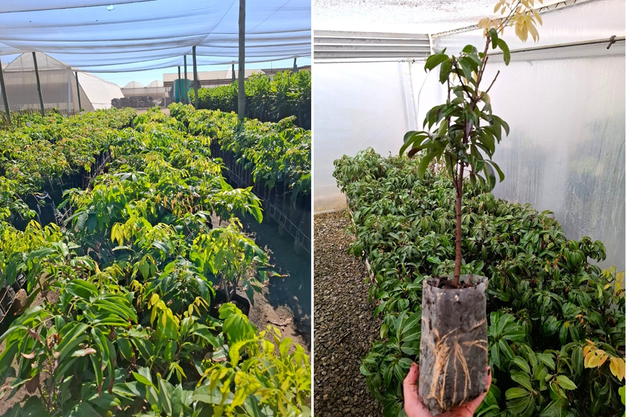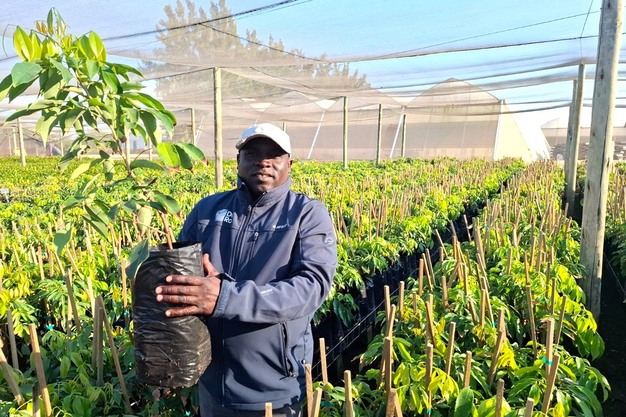It’s early spring, the time when South African litchi growers have learnt over the past few seasons, sudden heatwaves followed by late cold snaps can wreak havoc on the crop when flowering orchards are extremely vulnerable.
The Mauritius cultivar, a heavy bearer with good shelf life, makes up the vast majority of commercial plantings in South Africa, but its drawback is a tendency to alternate bearing, exacerbating the effect of extreme weather. The second most planted cultivar, Maclean’s Red, has the disadvantage of a shorter shelf life. An export cultivar also needs to tolerate the effects of post-harvest sulphur treatment.
Rummaging through the cupboard of cultivars imported from China, Thailand, and Israel during the 1990s by the Agricultural Research Council, trials uncovered varieties that appear better adapted to weather extremes than the current standards.
“In addition to the tolerance of hotter, drier conditions,” remarks Duncan Reynhardt, technical manager at DuRoi Multiplant, “is the fact that earlier cultivars (October to November) are more suited to hotter areas while later cultivars (January to February) are more suited to cooler areas. These cultivars come into the market when the supply of mid-season cultivars, such as Mauritius, is limited.”
At the recent South African Litchi Growers’ Association (SALGA) technical symposium, Israeli researchers shared the cultivation practices they employ to grow litchis in their hot and dry climate, which, Reynhardt observes, is unfortunately what many litchi-producing areas of South Africa are starting to become.
“There’s a cultivar that really excites them, called Hung Long, originally from northern Vietnam. They find it performs very well in hotter areas.” Israeli researchers have been experimenting with shade nets, irrigation practices, and misting to protect the trees against temperature extremes and sunburn.
 © Du Roi Multiplant The first commercial batches of limited litchi varieties were released this year by Du Roi Multiplant
© Du Roi Multiplant The first commercial batches of limited litchi varieties were released this year by Du Roi Multiplant
New propagation technique speeds up availability
DuRoi Multiplant has had to maximise the amount of offspring they can generate from the handful of trees still alive from the litchi evaluation programme of thirty years ago.
“Du Roi Multiplant is actively expanding its supply of limited plant material by establishing dedicated mother blocks at its Letsitele premises and at the cultivar site in Georges Valley,” says Gavin Pirie, commercial manager. “These blocks house only a handful of trees from select varieties, yet they form the vital foundation for the first commercial batches released earlier this year.”
To expedite the amount of litchi trees available to growers, a method of taking cuttings is being employed to bulk up their supply. “We can make a lot more trees from fewer mother plants through this method than using the traditional air layering technique,” Pirie says.
Instead of the ten to fifteen air-layered clones from a tree, 200 or 300 cuttings can be made. “Just to add that some cultivars don’t actually root that well, as Duncan’s finding out in the nursery, in comparison to other cultivars.”
Trees are made available in two stages, he explains: either as field-ready trees after 12 to 16 months or as smaller plants in one-litre bags. Some small consignments have been sent to Africa already.
There is a waiting list for some of the more obscure varieties, but Pirie notes that the traditional commercial litchi cultivars (Mauritius, Fay Zee Siu, Wai-Chee, and Kaimana) are freely available for large-scale commercial developments from Du Roi Multiplant.
 © Du Roi Multiplant
© Du Roi Multiplant
For more information: Gavin Pirie
Gavin Pirie
DuRoi Multiplant
Tel: +27 15 345 1650
Email: [email protected]
https://duroinursery.co.za/
Source: The Plantations International Agroforestry Group of Companies
